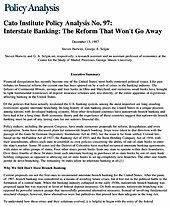Financial deregulation has recently become one of the United States’ most hotly contested political issues. Like past debates on financial reform, the current one has been spurred on by a rash of crises in the banking industry. The failures of Continental Illinois, savings and loan banks in Ohio and Maryland, and numerous small banks have brought to light fundamental weaknesses of deposit insurance schemes and, less directly, of the entire apparatus of regulations affecting banking in the United States.
Of the policies that have actually weakened the U.S. banking system, among the most important are long-standing restrictions against interstate branching. Its long history of unit banking places the United States in a unique position among nations with developed banking systems. Most other developed countries have nationwide branch banking and have had it for a long time. Both economic theory and the experience of these countries suggest that nationwide branch banking must be part of any lasting cure for our nation’s financial ills.
Policy makers, including the present Congress, have made numerous proposals for reform, deregulation, and even reregulation. Some have discussed plans for nationwide branch banking. Steps were taken in that direction with the passage of the Garn-St Germain Depository Institutions Act in 1982, but the issue is far from settled. Current law, based on the McFadden Act of 1927, the Banking Act of 1933, and the Bank Holding Company Act of 1956, with their amendments, allows each state to establish its own policies concerning the ability of out-of-state banks to enter the state’s market. Some 30 states and the District of Columbia have reached reciprocal interstate banking agreements with states or other groups of states. Four other states permit banks from any state to operate within their boundaries. Over three-fourths of these 34 states limit such interstate banking to purchases of in-state banks by out-of-state bank holding companies as opposed to allowing out-of-state banks to set up completely new branches. The other one-fourth permit de novo branching. The remaining 16 states allow no interstate banking at all.[1]
About the Authors

This work is licensed under a Creative Commons Attribution-NonCommercial-ShareAlike 4.0 International License.
